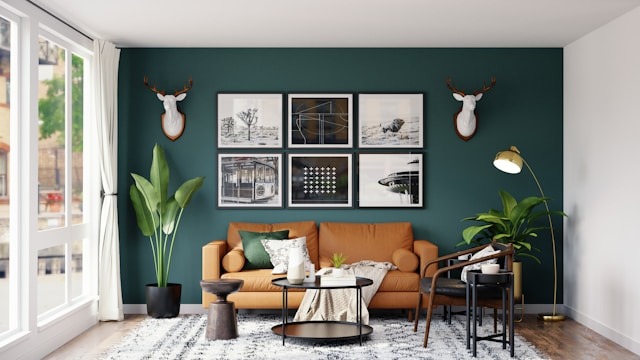
Design is more than decoration; it’s a dialogue between space, emotion, and intention. Whether it’s a single room or an entire property, impactful design stems from a clear understanding of how visual elements interact. When principles like balance, rhythm, and harmony come together, they create environments that not only impress but also feel deeply meaningful.
Here are eight timeless design principles that can transform any space into something truly remarkable, and how you can create a grand impact in whatever room you choose.
1. Scale and Proportion: Setting the Stage for Grandeur
One of the key foundations of impactful design lies in scale and proportion. Scale defines how large or small an element feels within a space, while proportion determines how those elements relate to one another.
In a grand entryway or open-plan living area, small décor items can feel lost. This is where oversized artwork, tall plants, or statement furniture create balance. Conversely, in compact rooms, proportion becomes crucial to avoid a cramped feeling. Each element, from the height of your furniture to the size of your rug, should be thoughtfully measured against the overall space.
When scale and proportion align, the result is a room that feels intentionally crafted and effortlessly grand.
2. Balance: Achieving Stability and Flow
Balance ensures that no single part of a room overpowers another. It creates a sense of calm, guiding the eye across the space naturally.
There are several types of balance to consider. Symmetrical balance is formal and traditional, mirroring objects on either side of a central point. Asymmetrical balance feels more dynamic, often used in modern interiors where visual equilibrium is achieved through contrast rather than replication. Radial balance extends from a central point, such as a circular dining arrangement or chandelier.
By achieving balance, you establish a visual rhythm that feels intuitive and timeless.
3. Rhythm: Creating a Sense of Movement
Rhythm is the pulse of design. It’s what connects one element to another through repetition, progression, or contrast.
You can establish rhythm by repeating colors, materials, or shapes throughout a room. For instance, a curved lamp that echoes the lines of a rounded sofa reinforces flow. Alternating tones or textures, such as glossy and matte finishes, introduces movement and energy without chaos.
When rhythm is thoughtfully applied, your eye glides across the space smoothly, allowing every feature to feel like part of a greater composition.
4. Contrast: Adding Depth and Drama
Contrast gives design its visual spark. It brings out the character of a space by combining elements that differ in tone, texture, or form.
This could mean pairing a sleek marble table with a rustic wooden floor, or layering dark walls with light furniture. Even a pop of vibrant color against a neutral backdrop can create a striking focal point. The key lies in moderation. Contrast should excite the senses without overwhelming them.
Through careful contrast, you add richness and energy that keep a room visually engaging.
5. Unity: Connecting Every Element
Unity ties all parts of a design together, creating a sense of wholeness. It ensures that every object, color, and texture feels like part of a cohesive vision.
To achieve unity, start with a clear design concept. For example, coastal minimalism or modern classic. Choose recurring elements that align with your theme and repeat them subtly across the space. Similar finishes, complementary colors, or shared materials reinforce this sense of connection.
Large-scale elements often play an anchoring role in unifying the room. A perfect example is introducing trendy large area rugs to define different zones in open spaces. They link furniture groups together through pattern and tone, adding structure while preserving flow.
6. Emphasis: Guiding the Eye Toward Significance
A focal point gives a space purpose and visual hierarchy. Without it, rooms can feel scattered or incomplete.
Identify one central feature that commands attention, such as a fireplace, a bold painting, or a sculptural light fixture. Once you establish it, arrange surrounding pieces to complement and highlight that element. Lighting is particularly effective for drawing focus, as are color contrasts and placement strategies that subtly guide the viewer’s gaze.
With a clear focal point, your design gains a narrative, which is one that leads the eye and sets the emotional tone of the space.
7. Harmony: Evoking Emotional Connection
Harmony is the invisible thread that weaves all design elements together into something deeply satisfying. It’s not about sameness but about balance and comfort.
When colors, materials, and proportions work together, the atmosphere becomes serene. Natural materials like wood and stone, combined with soft lighting and thoughtful textures, help establish this sense of harmony. Every design decision, from wall art to furniture spacing, contributes to an overall feeling of peace and completeness.
Harmony is the moment when a space feels exactly right: inviting, balanced, and human.
8. Light and Shadow: Sculpting Atmosphere
Great design doesn’t just fill space; it shapes light. The interplay between illumination and shadow defines mood and dimension.
Natural light should be celebrated whenever possible. It enhances colors, reveals texture, and energizes a room. During the evening, artificial lighting takes over, and layering becomes crucial. A mix of ambient, task, and accent lighting adds both practicality and drama. Shadows, meanwhile, bring depth, allowing architectural features or textured walls to stand out in subtle ways.
To create a sense of grandeur, consider how light behaves across surfaces throughout the day. It transforms static spaces into living, breathing environments that evolve with time.
The Lasting Power of Design Principles
Designing with impact is about more than visual appeal; it’s about emotion, energy, and intention. These eight principles, from proportion and rhythm to unity and light, form the foundation for any powerful design. When applied thoughtfully, they turn rooms into experiences, ensuring that every detail contributes to an atmosphere of purpose and beauty.
By embracing these ideas, you’re not just decorating. You’re crafting spaces that inspire, comfort, and endure, spaces that make a truly grand impression.








